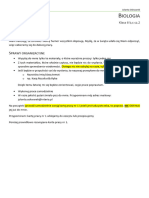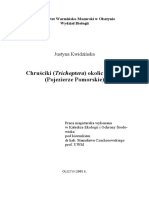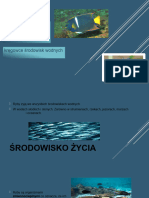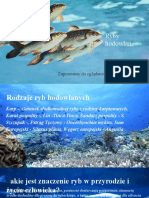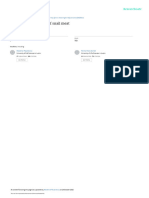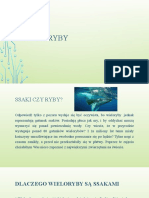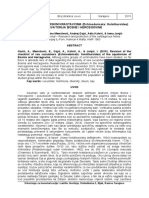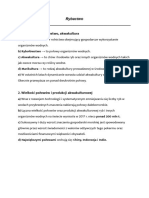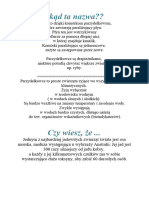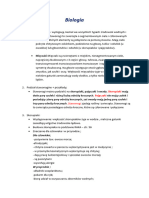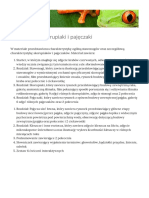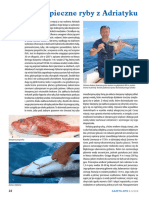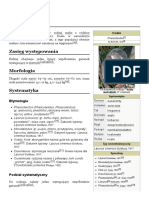Professional Documents
Culture Documents
2010 - The Reproduction of Neon Tetra, Paracheirodon Innesi (Myers, 1936), Under Controlled Conditions
Uploaded by
Fabrício BarrosCopyright
Available Formats
Share this document
Did you find this document useful?
Is this content inappropriate?
Report this DocumentCopyright:
Available Formats
2010 - The Reproduction of Neon Tetra, Paracheirodon Innesi (Myers, 1936), Under Controlled Conditions
Uploaded by
Fabrício BarrosCopyright:
Available Formats
POLISH JOURNAL OF NATURAL SCIENCES
Abbrev.: Pol. J. Natur. Sc., Vol 25(1): 8192, Y. 2010 DOI 10.2478/v10020-010-0006-x
THE REPRODUCTION OF NEON TETRA, PARACHEIRODON INNESI (MYERS, 1936), UNDER CONTROLLED CONDITIONS
Dariusz Kucharczyk1, Katarzyna Targoska1, Daniel arski1, Sawomir Krejszeff1, Krzysztof Kupren1, Marek J. uczyski2, Andrzej Szczerbowski2
1 Department of Lake and River Fisheries University of Warmia and Mazury in Olsztyn 2 Department of Aquaculture Inland Fisheries Institute in Olsztyn
K e y w o r d s: spawning, controlled conditions, aquarium fish, tetras, Characidae.
Abstract A study on reproduction of neon tetra has been carried out under controlled conditions. Neon tetra is very popular aquarium fish. It was observed that spawners of this species produce viable gametes during a few (56) spawning periods only. From the breeding perspective fish of that species should be reproduced again shortly after the completed spawning and time between spawns should be 15 to 20 days. Keeping the fish between spawning periods more than 20 days results in a significant deterioration of quality of gametes, expressed by the decreased number of 12-day-old larvae. It was shown that before spawning spawners should be kept in water at 22oC. The negative effect of keeping the reproducers in water at 25oC accumulated with time.
ROZRD NEONA INNESA, PARACHEIRODON INNESI (MYERS, 1936), W WARUNKACH KONTROLOWANYCH
Dariusz Kucharczyk1, Katarzyna Targoska1, Daniel arski1, Sawomir Krejszeff1, Krzysztof Kupren1, Marek J. uczyski2, Andrzej Szczerbowski2
1 Katedra Rybactwa Jeziorowego i Rzecznego Uniwersytet Warmisko-Mazurski w Olsztynie 2 Zakad Akwakultury Instytut Rybactwa rdldowego w Olsztynie
S o w a k l u c z o w e: taro, warunki kontrolowane, ryby ornamentalne, bystrzyki, Characidae.
Address: Dariusz Kucharczyk, University of Warmia and Mazury, ul. Oczapowskiego 5, 10-957 Olsztyn, Poland, phone: +48 (89) 523 42 15, e-mail: dariusz.kucharczyk@uwm.edu.pl
82
Dariusz Kucharczyk et al.
Abstract
Przeprowadzono badania nad rozrodem neona Innesa w warunkach kontrolowanych. Neon Innesa jest bardzo popularn ryb akwariow. Odnotowano, e od tarlakw tego gatunku jest moliwe uzyskanie dobrej jakoci gamet podczas kilku (56) kolejnych tare. Z hodowlanego punktu widzenia ryby powinno si rozmnaa krtko po skoczonym rozrodzie, a kolejne tara powinny odbywa si midzy 15 a 20 dniem. Przetrzymywanie ryb midzy kolejnymi tarami duej ni 20 dni skutkuje znacznym obnieniem jakoci gamet, wyraonej jako zmniejszona liczba 12-dniowych larw. Uzyskane wyniki wskazuj, i tarlaki midzy tarami powinny by przetrzymywane w wodzie o temperaturze 22oC. Odnotowano nasilenie si negatywnego efektu przetrzymywania ryb w temperaturze 25oC.
Introduction
The aquaculture of commercial, ornamental and aquarium fishes are strictly depending from methods of reproduction and fry rearing. In case of freshwater fishes, the reproduction under controlled conditions was usually done using hormonal stimulation (BRZUSKA 2000, 2005, 2006, KUCHARCZYK et al. 2008a). The necessity of application hormonal stimulation is especially good visible when wild cyprinids are reproduced (KUCHARCZYK et al. 1997a, b, c, 2005, SZABO 2003, KOURIL et al. 2007, KREJSZEFF et al. 2008, TARGOSKA et al. 2008, ARSKI et al. 2009). The last published research showed, that in domesticated stock is possible to reproduce fish without application of spawning agents (KREJSZEFF et al. 2009). In other species, i.e. percids, the fish can spawn without hormonal stimulation, but application of spawning agent involves spawning synchronization (KUCHARCZYK et al. 1996, 1998). Aquaculture of ornamental fish species is an important part of fisheries (TLUSTY 2002, BALON 2004, CEK, GOKCE 2005, CHELAPPA et al. 2005). Breeding aquarium fish is developing particularly dynamically in Asia although recently an extensive development has also been observed in some European countries. Characidae is one of the groups of decorative fish commonly bread worldwide. They live mainly in the tropical waters of South America. The best-known representatives of that group are tetras, which cultured stocks are usually domesticated (ELIAS 2003, BALON 2004). The neon tetra Paracheirodon innesi (Myers, 1936) is one of the most valuable species in the ornamental fish trade (WIETZMAN, FINK 1987). Most fish of this species available in the market are imported from South-East Asia, where they are raised in the fish farms, or from South America, where they are collected from the wild (CHAPMAN et al. 1998). Annually 1215 million neon-tetras collected from the wild are exported; this is about 80% of the total market of ornamental fish of the Amazon State (CHAO 2001). This situation led to the fear that this species may be doomed
The Reproduction of Neon Tetra...
83
to extinction (BAYLEY, PETRERE 1989). For this reason the propagation methods of different aquarium fish in captivity should be developed and published (OLIVIER, KEISER 1997, GOSH et al. 2007). The tetras (Characidae), including neon tetra are one of the most popular groups of fishes that are kept in modern aquariums. They are generally colourful and small in size and most of them only grow to 35 cm of total length and can be kept in small tanks, which are more suitable for the beginning hobbyist (KUCHARCZYK et al. 2008b, KUPREN et al. 2008). Neon tetra is much less sensitive than cardinal tetra Paracheirodon axelrodi (SCHULTZ 1956) and more popular as aquarium fish. Generally, tetras prefer soft, slightly acid water which resembles to natural conditions. The water of streams and rivers in Amazon region are poor in nutrients and minerals but rich in humic acids (JUNK, SOARES 2001). The reproduction of these species in captivity is not easy, but aquarists have been trying to reproduce them since the middle of XX century. The neon tetra was first described by Myers at 1936, but was discovered by Rabaut short time earlier in the Amazon, near Tabatinga town (ELIAS 2003, BALON 2004). The high market pressure stimulated the development of breeding and rearing methods of tetras (KUCHARCZYK et al. 2008b, KUPREN et al. 2008), but because the aquaculture of this species is a valuable business, only some limited data concerning such information like methods of spawning are printed (CHAPMAN et al. 1998). The aim of this study was to reproduce of neon tetra under controlled conditions.
Material and Methods
Spawners Fish for broodstock were obtained from domesticated stock from one of the Czech fish farm and transported to the Laboratory of Aquaculture at Department of Lake and River Fisheries, Warmia and Mazury University in Olsztyn. The collected fish (over 600 specimens) were about 1 cm of total length. Initially they were reared at 1 m3 tank (KUJAWA et al. 1999). Later, the fish were reared during four months at constant temperature (22oC) in recirculated water system (KUJAWA et al. 2000). The water parameters are presented in Table 1. Fish were fed two times daily with frozen natural food: zooplankton, Chironomids and mosquito larvae.
84
Dariusz Kucharczyk et al.
Table 1 Characteristics of water quality for rearing and spawning of neon tetra Type of aquarium Characteristics Temperature ( C) Total hardness (on) Permanent hardness (on) pH NH3, NO2 (mg dm3) Conductivity (S) Addition of humic acid
o
rearing 22 45 23 6.97.4 < 1.0 48116 no
spawning 25 0 0 5.56.5 0 2830 yes: 0.04%
Initial spawning Prior to spawning the fish were segregated according to sex for a period of three weeks and fed three times a day intensively. When the fish reached 2.53.5 cm of total length, they were moved to the spawning tanks in order to prepare them to the first spawning. The spawn was stimulated by manipulation of environmental conditions, which was described in details in Table 1. A spawning substrate (nylon brush) was used for egg deposition. The females which spawned were used to further experiments. The first spawn (called as mass) was made in 90 small aquariums (7 dm3 each). 3 females and 3 males were moved to each tank. Between the experimental spawnings all of the spawners were kept separately (males and females). Physicochemical parameters of water used for neon tetra spawning were constant. For that purpose water prepared was obtained from the process of reversed osmosis, and the water with carbon hardness 0odH and total hardness at 0on was obtained. The addition of humic acid was done. The temperature of water in spawning tanks was 25oC. All fish, except in experiment 3, were kept at 22oC between the spawning acts. On the bottom of the tank spawn grilles with mesh size of 5 mm were placed. The tanks were aerated. The spawning tanks were placed in dark as neon tetra eggs are sensitive to light. Three times a day the tanks were checked whether spawning took place. After completed spawning the fish were caught. The 12-day-old fry was counted on the basis of 5 return samples. At this age fish might be counted without influence on their mortality and on the other hand, they are not sensitive to intensive light at this time. Experiment 1. The aim of the first experiment was the investigation the effect of consecutive spawning acts on the number of obtained larvae. For that purpose 10 reproductive pairs (1 male and 1 female) were used. Spawners were placed in the late afternoon into the small tanks (7 dm3 each). Spawning
The Reproduction of Neon Tetra...
85
usually began on the next (or second) day around dawn and lasted from one to four hours. The pairs were removed immediately after completed spawning. Every 15 days they were moved to spawning tanks again. The number of fry was counted when the larvae were 12-day-old after hatching. The neon tetra larvae were fed 5 times daily using SF origin artemia nauplii (LIM et al. 2002). Experiment 2. In the second experiment the investigation concerned the duration of the most appropriate period between spawning from the breeding perspective. For that purpose 10 reproductive pairs that successfully completed the first spawning were moved every 5 days to spawning tanks (7 dm3). After completed spawning the procedure was the same as in experiment 1. Experiment 3. The third experiment investigated the influence of the temperature (22 and 25oC) of water in which fish were kept before spawning on the results of spawning. For that purpose two sets of fish (10 reproductive pairs each) were used. They were moved to the spawning tanks three times, at 15-day intervals. After completed spawning the procedure was the same as in experiment 1. Experiment 4. The last experiment the investigation of the influence of broodfish pairs number on spawning results. For this reason 1, 2, 3, 4, 5 or 10 tetra pairs were moved to the spawning tanks (7 dm3 each). After completed spawning the procedure was the same as in experiment 1. Experiment was made in triplicate.
Statistics
The obtained results were analyzed statistically. The differences in the number of 12-day-old larvae between groups in individual experiments were processed by variance analysis and Tuckeys post-hoc test at significance level of 5%. The correlation between the number of larvae and the consecutive spawning as well as intervals between individual spawning acts and number of pairs were subjected to regression analysis.
Results
Whatever type of experiment was conducted the percentage of ovulating females was high, ranging from 90% to 100%. Neon tetra spawners produced viable gametes during seven following spawns (Figure 1), including the first mass spawning. The highest number of 12-day old larvae was obtained after spawn No. 3 and 2. From spawn No. 5 the number of larvae dramatically decreased. From spawning No. 7 and three next ones no single viable individual was obtained.
86
Dariusz Kucharczyk et al.
70 60
c b ab
number of offspring per female
50 40 30 20 10 0 mass 1 2 3 4 5 spawns 6 7 8 9 10
e
y = -0.1608x2 5.7063x + 70.727 R2 = 0.8122
d
Fig. 1. The influence of the number of completed spawning acts on the average numbers of 12-day-old larvae obtained from one pair of the neon tetra spawners. The data marked by the same letter index within individual spawning acts do not differ statistically
80 70 60 50 40 30 20
b b b a
y = -3.8452x2 + 23.798x + 23.714
a
number of offspring per female
R2 = 0.7167
10 0 mass 5 10 15 20 period between spawns (days) 25
30
Fig. 2. The influence of the length of interval between spawning acts on the average numbers of 12-day-old larvae obtained from one spawning pair of neon tetra. The data marked by the same letter index within individual spawning acts do not differ statistically
The Reproduction of Neon Tetra...
87
70
number of offspring per female
60 50 40 30 20 10
y = 0.5x + 58.667 R2 = 0.75
b b
y = -8x + 28
b
R2 = 0.9552
0 1 2 spawns 22oC 25oC 3
Fig. 3. The influence of the temperature of water used for keeping the neon tetra spawners on the average numbers of 12-day-old larvae obtained from a single spawning pair. The data marked by the same letter index within individual spawning acts do not differ statistically
70
number of offspring per female
60 50 40 30 20 10 0
b b
y = -x2 + 2.4286x + 53.286
c
R2 = 0.9308
cd d
mass
2 3 4 period between spawns (days)
10
Fig. 4. The influence of the number of breeder pairs on the average number of 12-day-old larvae obtained from of the neon tetra spawners. The data marked by the same letter index within individual spawning acts do not differ statistically
Figure 2 presents the numbers of 12-day-old larvae (per female) obtained from spawning acts, performed at fixed time intervals (after 5, 10, 15, 20, 25 and 30 days) from the first (mass) spawning. It was demonstrated that the interval between individual reproductive acts in case of neon tetra should be from 15 to 20 days. Keeping the fish longer than 20 days before consecutive spawning resulted in a significant decrease of the hatch numbers obtained.
88
Dariusz Kucharczyk et al.
For example, when comparing the number of larvae obtained in case of 20 and 30-day interval between spawning acts an almost 6 times decrease in the number of larvae was noted. It was also showed that the level of temperature, in which spawners were kept before spawning act is important for the number of obtained viable larvae (Figure 3). Keeping the fish at the higher of the tested temperatures (25oC) had a significant influence on decreasing the numbers of offspring obtained as compared to the results obtained when the fish before spawning were kept in water at 22oC. Accumulation of the negative effect of the temperature in case of keeping the spawners at 25oC for a longer time was also demonstrated. The results of the influence of number of breeders pairs on quantity of 12-day-old larvae are presented in Figure 4. The highest number of larvae per female (about 60) was noted when a single pair was used for spawning. But, i.e., when 10 pairs were moved to the spawning tanks, the total production of larvae was over 280. During all the experiments no spawners mortality was recorded.
Discussion
The industrial catching of ornamental fishes from the wild influenced their significant decline (RAGHAVAN et al. 2007). The main problem is that in many cases the collection of fish from the wild is cheaper than their breeding in captivity. Also spawn of wild fish is more difficult in captivity. This situation should be changed by fish domestication (BALON 2004, KREJSZEFF et al. 2009). Many aquarium fishes were spawned in captivity after manipulation of environmental conditions only (KUCHARCZYK et al. 2008b). The same situation was noted in the case of neon tetra, where increasing the temperature, darkness and preparing water was enough for stimulation of final maturation of gametes. In modern aquaculture obtaining high quality gametes, which allows both obtaining the required number of larvae for initial rearing and planning of production, is one of the most important problems to be solved. It is also highly important from the economic perspective. This applies not only to fishes reared for consumption but also other fish including the decorative and aquarium species. Numerous factors influence the effects of reproduction, which are in this study understood as spawning and obtaining a specific number of larvae from the spawn. They include, among others, the fish diet and environmental conditions. According to BROOKS et al. (1997) the differences between species in the observed influence of environmental conditions on effectiveness of fish reproduction and quality of gametes produced by them were described.
The Reproduction of Neon Tetra...
89
In some cases the environmental conditions which the spawners are kept in can also affect offspring rates of survival and growth as well as the resistance to stress (BROOKS et al. 1997, TARGOSKA 2007). The viable offspring of neon tetra can be obtained during a few initial reproductive acts only (counting from the first, controlled spawning). Later, although the fish performed the reproduction and laid eggs, the obtaining of viable offspring is not possible. A similar situation was noted in other Characidae, i.e. Buenos Aires tetra (Hyphessobrycon anisitsi Eigenmann, 1907) (KUCHARCZYK et al. 2008b). On the basis of the data obtained from the presented experiments it can be concluded that during further reproduction, the eggs were laid but hatched larvae were not obtained. The developing eggs usually died during the initial hours of incubation. That observation is confirmed by numerous observations reported by aquarium owners and it is a characteristic of Characidae. During these studies not a single viable hatch was obtained from spawning No. 7 and next. Considering the number of spawning pairs and the data published by SCHEURMAN (1990) on fecundity of this species it should be estimated that not a single larvae hatched from around 20003000 eggs. Similar data (except fecundity) was obtained for Buenos Aires tetra by KUCHARCZYK et al. (2008b). The number of obtained fry per one female, in the present experiment ranged between 50 and 60. These data are similar to those published by CHAPMAN et al. (1998). Neon tetra reared in the laboratory by those authors produced a significantly higher number of larvae (82 larvae/female) than broodstock collected from the wild or cultured (28 larvae/female). But in the present work the 12-day-old larvae were counted not new-hatched larvae. The influence of some factors (positive or negative) on the effect of fish reproduction can accumulate over time. That was confirmed, among others, by TARGOSKA (2007) during studies on the influence of feeding of reproducers on the effects of reproduction of genus Symphysodon. The accumulation of negative influence of high water temperature in which spawners were kept was also found in case of the studied species of tetras: neon (present paper) and Buenos Aires tetra, when extended keeping of fish in water at 25oC caused a decrease in the number of offspring (KUCHARCZYK et al. 2008b). The influence of water temperature on reproductive capability has been described for many fish species (KRAAK, PANKHURST 1996). A similar relation between the temperature at which the spawners were kept before reproduction and survival of the embryos and larvae was observed in case of Menidia beryllina (Cope, 1867), when the fish were kept under controlled conditions (HUBBS, BRYAN 1974). The results of studies indicate that keeping spawners of neon tetra in excessively high temperature and for excessively long intervals between consecutive spawning actions can significantly influenced on effects
90
Dariusz Kucharczyk et al.
of reproduction. It was demonstrated that during selection of reproducers to the spawning stock the number of completed spawning actions and the time between them should also be considered. The results presented in this paper fill the information gap concerning biotechnology of aquarium fish reproduction, which is quite significant also for species highly popular in aquaculture and for economic point of view (HAKU-BAOWSKA et al. 2009) during this species culture.
Translated by AUTHORS Accepted for print 3.11.2009
References
BALON E.K. 2004. About the oldest domesticates among fishes. J. Fish Biol., 65 suppl. A: 127. BAYLEY P. B., PETRERE JR. M. 1989. Amazon fisheries: assessment methods, current status and management options. Proceedings of the International Large River Symposium. Ed. D.P. Dodge. Can. Fish. Aquat. Sci., Spec. Publ., 106: 385398. BROOKS S., TYLER C.R., SUMPTEM J.P. 1997. Egg quality in fish: what makes a good egg? Rev. Fish Biol. Fish., 7: 387416. BRZUSKA E. 2000. Artificial spawning of carp Cyprinus carpio L.: differences between the effects on reproduction in females of Polish and Hungarian provenance treated with carp pituitary and (D-Ala6) GnRH ProNHEt (Kobarelin). Aquacult. Res., 31: 457465. BRZUSKA E. 2005. Artificial spawning of carp (Cyprinus carpio L.): differences between females of Polish strain 6 and Hungarian strain W treated with carp pituitary homogenate, Ovopel or Dagin. Aquacult. Res., 36: 10151025. BRZUSKA E. 2006. Artificial spawning of female Lithuanian strain B carp (Cyprinus carpio L.) after treatment with carp pituitary homogenate, Ovopel or [D-Tle6, ProNHEt9] GnRH-a (Lecirelin). Aquacult. Res., 37: 264271. CEK S., GOKCE M.A. 2005. Evaluation of the photocopy method for counting Puntius conchonius eggs. Turk. J. Vet. Anim. Sci., 29: 685689. CHAO N.L. 2001. The fishery diversity and conservation of ornamental fishes in the Rio Negro Basin, Brasil: A review of Project Piaba (19891999). [In:] Conservation and management of ornamental fish resources of the Rio Negro Basin, Amazonia Brasil Project Piaba. Eds N.L. Chao, P. Petry, G. Prang, L. Sonnenschein, M.T. Tlusty, Manaus, Brasil pp. 161204. CHAPMAN F.A., COLLE D.E., ROTTMANN R.W., SHIREMAN J.V. 1998. Controlled spawning of the neon tetra. Progr. Fish-Cult., 60: 3237. CHELAPPA S., CAMARA M.R., VERANI J.R. 2005. Ovarian development in the Amazonian Red Discus, Symphysodon discus Heckel (Osteichthyes: Cichlidae). Braz. J. Biol., 65: 609616. ELIAS J. 2003. Tetra neonovh Paracheirodon innesi (Myers, 1936) (The neon tetra). Akvarium Terarium 46: 411. GOSH S., SINCHA A., SAHU C. 2007. Effect of probiotic on reproductive performance in female livebearing ornamental fish. Aquacult. Res., 38: 518526. HAKU-BAOWSKA A., KUPREN K., TURKOWSKI K., TARGOSKA K., JAMRZ M., KREJSZEFF S., KWIATKOWSKI M., ARSKI D., KUCHARCZYK D. 2009. Comparison of economic effectiveness of applying different hormonal preparations for reophile cyprinid fish reproduction stimulation based on the example of asp Aspius aspius (L.) and ide Leuciscus idus (L.). Pol. J. Nat. Sci. 24(4): 224234. HUBBS C., BRYAN C. 1974. Effect of parental temperature experience on thermal tolerance of eggsof Menidia audens. [In:] The Early Life History of Fish. Ed. J.H.S. Blaxter. Springer, pp. 431435. JUNK W.J., SOARES M.G.M. 2001. Freshwater fish habitats in Amazonia: state of knowledge, management, and protection. Aquatic Ecosystem Health & Management, 4: 437451. KOURIL J., SVOBODA M., HAMACKOVA J., KALAB P., KOLAROVA J., LEPICOVA A., SEDOVA M., SAVINA L., MORENO RENDN P., SVOBODOVA Z., BARTH T., VYKUSOVA B. 2007. Repeated administration
The Reproduction of Neon Tetra...
91
of different hormonal preparations for artificial propagation and their effects on reproduction, survival and blood biochemistry profiles of female tench (Tinca tinca L.). Czech J. Anim. Sci., 52(6): 183188. KRAAK G.V.D., PANKHURST N.M. 1996. Temperature effects on the reproductive performance of fish. [In:] Global Warning: Implications for freshwater and marine fish. Eds. C.M. Woods, D.G.McDonalds. Cambridge University Press, pp. 159176. KREJSZEFF S., KUCHARCZYK D., KUPREN K., TARGOSKA K., MAMCARZ A., KUJAWA R., KACZKOWSKI Z., RATAJSKI S. 2008. Reproduction of chub, Leuciscus cephalus L., under controlled conditions. Aquacult. Res., 39: 907912. KREJSZEFF S., TARGOSKA K., ARSKI D., KUCHARCZYK D. 2009. Domestication affects spawning of the ide (Leuciscus idus) preliminary study. Aquaculture, 295: 145147. KUCHARCZYK D., KUJAWA R., MAMCARZ A., SKRZYPCZAK A., WYSZOMIRSKA E. 1996. Induced spawning in perch, Perca fluviatilis L. using carp pituitary extract and HCG. Aquacult. Res., 27: 847852. KUCHARCZYK D., KUJAWA R., UCZYSKI M., GLOGOWSKI J., BABIAK I., WYSZOMIRSKA E. 1997a. Induced spawning in bream, Abramis brama (L.), using carp and bream pituitary extract and hCG. Aquacult. Res., 28: 139144. KUCHARCZYK D., KUJAWA R., MAMCARZ A., WYSZOMIRSKA E. 1997b. Artificial spawning in bream (Abramis brama (L.)). Pol. Arch. Hydrobiol., 44: 203207. KUCHARCZYK D., KUJAWA R., MAMCARZ A., WYSZOMIRSKA E. 1997c. Induced spawning in rudd (Scardinius erythrophthalmus L.). Pol. Arch. Hydrobiol., 44: 209213. KUCHARCZYK D., KUJAWA R., MAMCARZ A., SKRZYPCZAK A., WYSZOMIRSKA E. 1998. Induced spawning in perch, Perca fluviatilis L., FSH + LH with pimozide or metoclopramide. Aquacult. Res., 29: 131136. KUCHARCZYK D., KUJAWA R., MAMCARZ A., TARGOSKA-DIETRICH K., WYSZOMIRSKA E., GLOGOWSKI J., BABIAK I., SZABO T. 2005. Induced spawning in bream (Abramis brama L.) using pellets containing GnRH. Czech J. Anim. Sci., 50: 8995. KUCHARCZYK D., TARGOSKA K., HLIWA P., GOMUKA P., KWIATKOWSKI M., KREJSZEFF S., PERKOWSKI J. 2008a. Reproductive parameters of common carp (Cyprinus carpio L) spawners during natural season and out-of-season spawning. Reprod. Biol., 8(3): 285289. KUCHARCZYK D., TARGOSKA K., PRUSISKA M., KREJSZEFF S., KUPREN K., KUJAWA R., MAMCARZ A. 2008b. Reproduction of Buenos Aires tetra (Hemigrammus caudovittatus) under controlled conditions. Pol. J. Nat. Sci., 23(4): 858865. KUJAWA R., KUCHARCZYK D., MAMCARZ A. 1999. A model system for keeping spawners of wild and domestic fish before artificial spawning. Aquacult. Eng., 20: 8589. KUJAWA R., MAMCARZ A., KUCHARCZYK D., SKRZYPCZAK A. 2000. An experimental unit for rearing of larval freshwater fish. Fol. Univ. Agric. Stetin., Piscaria, 205: 103108. KUPREN K., KUCHARCZYK D., PRUSISKA M., KREJSZEFF S., TARGOSKA K., MAMCARZ A. 2008. The influence of stocking density on survival and growth of Buenos Aires tetra Hemigrammus caudovittatus larvae reared under controlled conditions. Pol. J. Nat. Sci., 23(4): 881887. LIM L. C., CHO Y. L., DHERT P., WONG C. C., NELIS H., SORGELOOS P. 2002. Use of decapsulated Artemia cysts in ornamental fish culture. Aquacult. Res., 33: 575589. OLIVIER A., KEISER H. 1997. A comparison of growth, survival rate, and number of maricetabie fish produced of swordtaiis, Xiphophorus hellerl Heckei (Family Poeciliidae), between two types of culture systems. Aquacult. Res., 28: 215221. RAGHAVAN R., TLUSTY M., PRASAD P., PEREIRA B., ALI A., SUJARITTANONTA L. 2007. Should endemic and threatened freshwater ornamental fishes of Kerala part of the Western Ghats biodiversity hotspot be captive bread for international trade? Current Science, 93: 12111213. SCHEURMANN I. 1990. Aquarium Fish Breeding. Barons Educational Series Inc. Hauppauge, N.Y. 144 pp. SZABO T. 2003. Ovulation induction in northern pike Esox lucius L. using different GnRH analogues, Ovaprim, Dagin and carp pituitary. Aquacult. Res., 34: 479486. TARGOSKA K. 2007. Wykorzystanie larw ochotek z rodzaju Chironomus w hodowli wybranych gatunkw ryb. PhD Thesis. UWM Olsztyn, pp.140. (in Polish with English summary). TARGOSKA K., KUCHARCZYK D., MAMCARZ A., GLOGOWSKI J., KREJSZEFF S., PRUSISKA M., KUPREN K. 2008. Influence of individual variability in the percentage of motile spermatozoa and motility time on the survival of embryos of chosen fish species. Pol. J. Nat. Sci., 23(1): 178187.
92
Dariusz Kucharczyk et al.
TLUSTY M. 2002. The benefits and risks of aquacultural production for the aquarium trade. Aquaculture, 205: 203219. WEITZMAN S.H., FINK W. L. 1987. Neon Tetra relationships and phylogenetic systematics. Tropical Fish Hob., 36: 7277. ARSKI D., KUCHARCZYK D., TARGOSKA K., JAMRZ M., KREJSZEFF S., MAMCARZ A. 2009. Application of ovopel and ovaprim and their combinations in controlled reproduction of two reophilic cyprinid fish species. Pol. J. Nat. Sci., 24(4): 235244.
You might also like
- Wybieg Krolikow przewodnik inżynierów danych po królikach, królikologii i królikach: GuidesFrom EverandWybieg Krolikow przewodnik inżynierów danych po królikach, królikologii i królikach: GuidesNo ratings yet
- Mały Słownik Zoologiczny - Ryby - Krystyna Kowalska (1991)Document208 pagesMały Słownik Zoologiczny - Ryby - Krystyna Kowalska (1991)pocztajacekNo ratings yet
- Ryby Klasa ViDocument21 pagesRyby Klasa Vikontospamowe1No ratings yet
- Biologia Klasa 6.b.c.J.Oskwarek - cz2-1Document5 pagesBiologia Klasa 6.b.c.J.Oskwarek - cz2-1Anita Lenart GrabowskaNo ratings yet
- Dokument BiologiaDocument6 pagesDokument BiologiaXxKuba Paradowski xX OfficialNo ratings yet
- Przykładowe Zestawy Ryb I Roślin W AkwariumDocument21 pagesPrzykładowe Zestawy Ryb I Roślin W AkwariumFernandoNo ratings yet
- Chruściki (Trichoptera) Okolic Kartuz (Pojezierze Pomorskie)Document34 pagesChruściki (Trichoptera) Okolic Kartuz (Pojezierze Pomorskie)iyhdhqplvzfdxwloiwNo ratings yet
- Karta Pracy - RybactwoDocument2 pagesKarta Pracy - Rybactwoantekd4No ratings yet
- Kurier Czaplinecki - NR 110, Lipiec 2022Document12 pagesKurier Czaplinecki - NR 110, Lipiec 2022Adam CyganNo ratings yet
- 12 KowalskaDocument3 pages12 Kowalskarubaakjakub967No ratings yet
- Akwarium MorskieDocument31 pagesAkwarium MorskieSylwester TokarzNo ratings yet
- Inteligentne RybyDocument3 pagesInteligentne RybyFaustyna CzajkaNo ratings yet
- Afrykańskie PielęgniceDocument3 pagesAfrykańskie PielęgniceSandra PykNo ratings yet
- Krewetka o WydrukuDocument4 pagesKrewetka o WydrukuAnna ŁysikNo ratings yet
- Prezentacja Ryby Klasa VIDocument11 pagesPrezentacja Ryby Klasa VIarktos059No ratings yet
- Kopia Prezentacja Bez TytułuDocument10 pagesKopia Prezentacja Bez TytułuBartek OkNo ratings yet
- Żarłacz BiałyDocument4 pagesŻarłacz BiałyJoanna KNo ratings yet
- Venomous Snakes of Uzbekistan: Jadowite Węże UzbekistanuDocument10 pagesVenomous Snakes of Uzbekistan: Jadowite Węże UzbekistanuAngel Eduardo Moreno AlboresNo ratings yet
- 2014 - Production and Quality of Snail Meat - MWDocument8 pages2014 - Production and Quality of Snail Meat - MWFaycalHamamaNo ratings yet
- Ogolna Charakterystyka RybDocument30 pagesOgolna Charakterystyka RybFaustyna CzajkaNo ratings yet
- Ogrody ZoologiczneDocument16 pagesOgrody ZoologiczneKasia NawrotNo ratings yet
- WIELORYBYDocument22 pagesWIELORYBYAnna SołtysińskaNo ratings yet
- OSP Memisevic Et Al Popis Morskih Krastavaca U BiHDocument6 pagesOSP Memisevic Et Al Popis Morskih Krastavaca U BiHArmin GanicNo ratings yet
- Zwierzeta Swiata VI B 1608634996Document17 pagesZwierzeta Swiata VI B 1608634996kjhhjhjNo ratings yet
- RybactwoDocument3 pagesRybactworasti1No ratings yet
- Pakiet 02 15 Dzień WielorybówDocument29 pagesPakiet 02 15 Dzień WielorybówQuiet PlaceNo ratings yet
- Kopia Kopia - Kopia Kopia PrezentacjaDocument23 pagesKopia Kopia - Kopia Kopia PrezentacjaJulia AdamowskaNo ratings yet
- Ryby MorskieDocument16 pagesRyby MorskieFaustyna CzajkaNo ratings yet
- Koale W AustraliiDocument9 pagesKoale W AustraliiAmelia MalecNo ratings yet
- Prezentacja RybyDocument15 pagesPrezentacja RybyMichał ŻakNo ratings yet
- Ryby NotatkaDocument3 pagesRyby NotatkaEmilia KoseckaNo ratings yet
- PARZDocument4 pagesPARZAgnieszka PatynaNo ratings yet
- Dlaczego Ptaki Odbywają Coroczne Wędrówki?Document1 pageDlaczego Ptaki Odbywają Coroczne Wędrówki?digitalcustomerNo ratings yet
- The State of Knowledge Concerning BeetleDocument10 pagesThe State of Knowledge Concerning BeetleRobert LaseckiNo ratings yet
- Kręgowce ZmiennocieplneDocument7 pagesKręgowce ZmiennocieplneKatarzyna SmółkoNo ratings yet
- Adaptacje Gadow Do Zycia Na LadzDocument17 pagesAdaptacje Gadow Do Zycia Na LadzDawid NalepaNo ratings yet
- Stekowce I TorbaczeDocument3 pagesStekowce I TorbaczefreshingpowerNo ratings yet
- ZW 2013 11 10Document4 pagesZW 2013 11 10Filip CzepielaNo ratings yet
- Kurier Czaplinecki NR 181 - Wrzesień 2021Document12 pagesKurier Czaplinecki NR 181 - Wrzesień 2021Adam CyganNo ratings yet
- BiologiaDocument2 pagesBiologiamarta12kazimierzNo ratings yet
- Mechanizmy Ewolucji W BiologiiDocument7 pagesMechanizmy Ewolucji W Biologiij21372335No ratings yet
- RybyDocument2 pagesRybymartynaz7bNo ratings yet
- Swiat Pod LupaDocument893 pagesSwiat Pod Lupasadlocha.piotrNo ratings yet
- Kurier Czaplinecki - NR 207, Listopad 2023Document13 pagesKurier Czaplinecki - NR 207, Listopad 2023Adam CyganNo ratings yet
- PalpigradiDocument8 pagesPalpigradikingago80No ratings yet
- EwolucjaDocument5 pagesEwolucjasmrodo1313No ratings yet
- Stawonogi - Skorupiaki I PajeczaDocument20 pagesStawonogi - Skorupiaki I PajeczaEmilia SiedlinskaNo ratings yet
- Pijawki Pasozyty ZewnetrzneDocument20 pagesPijawki Pasozyty Zewnetrznex2vf7m8hbsNo ratings yet
- Kurier Czaplinecki - NR 195, Listopad 2022Document12 pagesKurier Czaplinecki - NR 195, Listopad 2022Adam CyganNo ratings yet
- Exobasidium Oxycocci (..) (Patejuk, 2017)Document5 pagesExobasidium Oxycocci (..) (Patejuk, 2017)Marek HalamaNo ratings yet
- Inbound 170045214852289756Document2 pagesInbound 170045214852289756zabiec121No ratings yet
- Co Zyje W OceanieDocument8 pagesCo Zyje W OceanieZuzanna MannNo ratings yet
- 11 FiszdonDocument3 pages11 FiszdonFilip CzepielaNo ratings yet
- Przeglad ParzydelkowcowDocument20 pagesPrzeglad ParzydelkowcowMarysia TrawińskaNo ratings yet
- Teriologia PDFDocument3 pagesTeriologia PDFpantyman20No ratings yet
- W Świecie Zwierząt - SsakiDocument26 pagesW Świecie Zwierząt - Ssakisan draNo ratings yet
- Koala - Wikipedia, Wolna EncyklopediaDocument3 pagesKoala - Wikipedia, Wolna EncyklopediaassecoNo ratings yet
- Życie W BałtykuDocument43 pagesŻycie W BałtykuFrancesDoloresNo ratings yet
- Oceany Zimne Oceany CiepeDocument5 pagesOceany Zimne Oceany CiepeBogudarzNo ratings yet
- Kurier Czaplinecki - NR 196, Grudzień 2022Document12 pagesKurier Czaplinecki - NR 196, Grudzień 2022Adam CyganNo ratings yet



